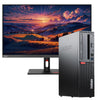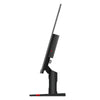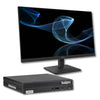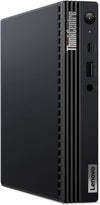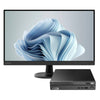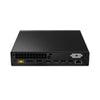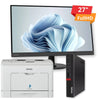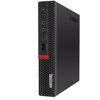Discover the FreeDOS PC, the smart, affordable choice for maximum customization freedom and control.
What is FreeDOS?
FreeDOS is an open-source DOS-compatible operating system designed to run programs that originally ran on MS-DOS . Created in 1994 in response to Microsoft 's announcement that future versions of Windows would no longer require DOS ( All Things Open ), FreeDOS offers users the ability to experience DOS on modern hardware.
FreeDOS Uses
FreeDOS has a wide range of uses, making it a versatile and practical choice for many types of users.
-
Running Classic DOS Games: Retro gaming enthusiasts can use FreeDOS to play historic DOS titles without the need for emulators.
-
Running Legacy Software: Companies that use legacy applications developed for MS-DOS can continue to run them with FreeDOS.
-
Developing New DOS Programs: FreeDOS includes several programming tools useful for those who want to develop new software for DOS ( FreeDOS ).

FreeDOS Usage Table
| Usage | Description |
|---|---|
| Classic Games | Run DOS games that don't run on modern operating systems. |
| Legacy Software | Keep legacy MS-DOS-compatible business applications running. |
| Programming | Develop new DOS programs using the tools included with FreeDOS. |
FreeDOS requires no installation to try: users can use the LiveCD version or run FreeDOS in a virtual machine within their operating system.
FreeDOS represents a convenient and flexible solution for those who want full control of the software installed on their PC.
Installing FreeDOS
FreeDOS versions
FreeDOS offers several versions to suit the needs of different users, especially those with older hardware or specific preferences in terms of installation method. The main versions available include:
| Version | Description | Use |
|---|---|---|
| 8086 Version | Includes FAT32 support, suitable for older hardware such as IBM PC, XT and AT models | Old hardware |
| FullUSB | Ideal for installation on real hardware without a CD-ROM drive | Physical machines without CD-ROM |
| LegacyCD | Provides an alternative boot method for systems without LiveCD support | Hardware without LiveCD support |
| Live CD | Allows you to try FreeDOS without installation and can be used in emulation | Tests without installation and emulation |
Source: ( FreeDOS )

Installation Methods
Now let's explore the main FreeDOS installation methods, tailored to different hardware situations and user preferences.
-
Installation via LiveCD
The LiveCD method allows users to try FreeDOS without a permanent installation on their system. This is especially useful for those who want to test FreeDOS before a full installation. By following these steps:
- Download the LiveCD image from the official FreeDOS website.
- Burn the image to a CD or create a bootable USB stick.
- Boot the system from the CD or USB stick.
-
Installation via FullUSB
This method is recommended for those who do not have a CD-ROM drive and want to install directly from a USB stick. For this:
- Download the FullUSB image.
- Use a tool to create a bootable USB stick (for example, Rufus).
- Boot your computer from the USB stick and follow the installation instructions.
-
Installation via LegacyCD
For systems that do not support LiveCD boot, LegacyCD offers an alternative. Follow these steps:
- Scan the LegacyCD image from the FreeDOS site.
- Burn the image to a CD.
- Boot the system from the CD and follow the installation instructions.
-
Installing in a Virtual Machine
Using a virtual machine is an effective method of running FreeDOS on modern systems without affecting the main operating system. Software modules such as Microsoft Virtual PC 2007 work well for this purpose ( Super User ). For this method:
- Install virtualization software such as Virtual PC or VirtualBox.
- Create a new virtual machine and configure it to use FreeDOS.
- Mount the FreeDOS ISO and boot the virtual machine.
These various options offer great flexibility, allowing everyone to choose the most convenient method based on their resources and preferences.

Advanced FreeDOS Usage
FreeDOS is an excellent choice for those who want to get the most out of their computer, especially those who like the idea of having full control over the hardware and software they use.
Running Legacy Programs
FreeDOS is ideal for running older games and legacy software that require a DOS environment. This is especially useful for retrogaming enthusiasts and professionals who need to run specialized applications that are not compatible with modern operating systems.
Some methods for running legacy programs under FreeDOS include:
- Direct execution on physical hardware : Install FreeDOS on a native PC or laptop to run DOS programs directly.
- Virtual Machines : Use a virtual machine to run FreeDOS on a modern computer. Microsoft Virtual PC 2007 is a suitable tool for installing FreeDOS or an older 32-bit Windows operating system in a virtual environment ( Super User ).
| Method | Advantages | Disadvantages |
|---|---|---|
| Physical Hardware | Native execution, maximum control | Hardware compatibility, maintenance |
| Virtual Machine | Ease of use, system isolation | System Resources, Initial Setup |
Developing New DOS Programs
FreeDOS is not just for running old programs, but also for developing new ones. Various programming tools are included, making the operating system flexible for developers and programmers.
- Development Environments : FreeDOS includes several development tools, such as compilers for programming languages like C and Pascal.
- Backward Compatibility : Creating programs compatible with older DOS systems is made easy thanks to the framework and tools included in FreeDOS.
- Comprehensive Documentation : Developers have access to comprehensive documentation and an active community that can answer questions and offer support ( FreeDOS ).
| Instrument | Main Features |
|---|---|
| C Compiler | Creating efficient DOS applications |
| mTCP NetDrive | Mounting Network Drives and Floppy Disk Images |
FreeDOS offers users maximum freedom of customization and control, making it a smart, economical choice for those who want to maximize their computing capabilities without the costs and limitations imposed by modern operating systems.
History and Development of FreeDOS
The history of FreeDOS is rich with significant events and contributions from a dedicated community of developers. This section explores the origins of the project and the major contributions to the development of FreeDOS.

Origins of FreeDOS
FreeDOS is an open-source operating system inspired by DOS, started in 1994. Its birth was spurred by Microsoft's announcement that the next version of Windows would no longer require DOS to run, making DOS obsolete. In response, the FreeDOS project was started on June 29, 1994, with the goal of creating an open-source version of DOS.
One of the first significant contributions was FreeCOM, a command shell developed by Tim Norman, a student. FreeCOM replaced DOS's COMMAND.COM, offering users their own version of the command shell ( All Things Open ).
Contributions and Project Development
Several individuals played key roles in the development of FreeDOS. One of the key contributors was Pat Villani, who developed a DOS-like kernel written in C. This kernel replaced the DOS kernel, becoming the heart of the operating system that runs programs and handles essential functions.
Some of the major contributors and developers of FreeDOS include:
- Tom Ehlert
- John Price
- Bart Oldman
- Steffen Kaiser
These developers, among many others, have worked on various aspects of the kernel and programming libraries, leading to continued improvements and developments of the operating system.
For the curious, here is a summary of the main contributors:
| Contributor | Role |
|---|---|
| Tim Norman | FreeCOM Development |
| Pat Villani | Kernel Development |
| Tom Ehlert | Contributions to the Kernel |
| John Price | Contributions to the Kernel |
| Bart Oldman | Contributions to the Kernel |
| Steffen Kaiser | Contributions with Libraries |
These contributions have allowed FreeDOS to constantly evolve, keeping the DOS legacy alive and offering an affordable and highly customizable solution for technology enthusiasts, developers, and IT professionals.



![AG15-71P-546C I5-13420H 16GB 1024GB 15 WIN 11 PRO [IMAGE 1] AG15-71P-546C I5-13420H 16GB 1024GB 15 WIN 11 PRO [IMAGE 1]](http://www.messoanuovo.it/cdn/shop/files/bG9jYWw6Ly8vaW1hZ2VzX2dhbGxlcnkvYy9iL2EvY2JhMGU4ZTZiNjRhMGYyYWJjMzgwZDFhN2ZlYzQxNzAvOGI2MWVhNWI2YzU4YjVmMWMwNTM4MTQ0MjczZmQ5M2U0N2NmNGI5Ny5qcGc.jpg?v=1747951400&width=100)
![AG15-71P-546C I5-13420H 16GB 1024GB 15 WIN 11 PRO [IMAGE 2] AG15-71P-546C I5-13420H 16GB 1024GB 15 WIN 11 PRO [IMAGE 2]](http://www.messoanuovo.it/cdn/shop/files/bG9jYWw6Ly8vaW1hZ2VzX2dhbGxlcnkvYy9iL2EvY2JhMGU4ZTZiNjRhMGYyYWJjMzgwZDFhN2ZlYzQxNzAvMGIzOTUwZGM2ODkyZGU2MWU3YThkZGU5NGU2YmQzYjYxZmVmMmNjZC5qcGc.jpg?v=1747951400&width=100)


